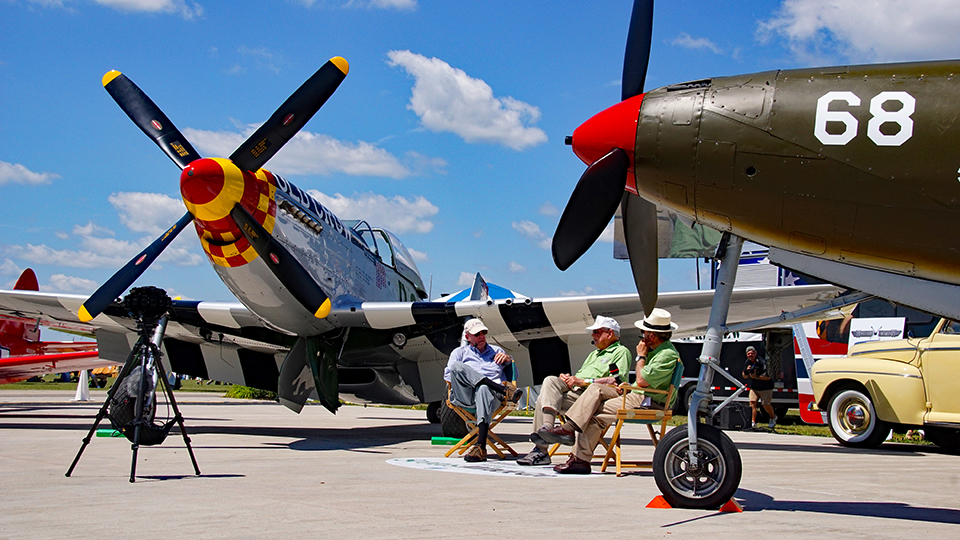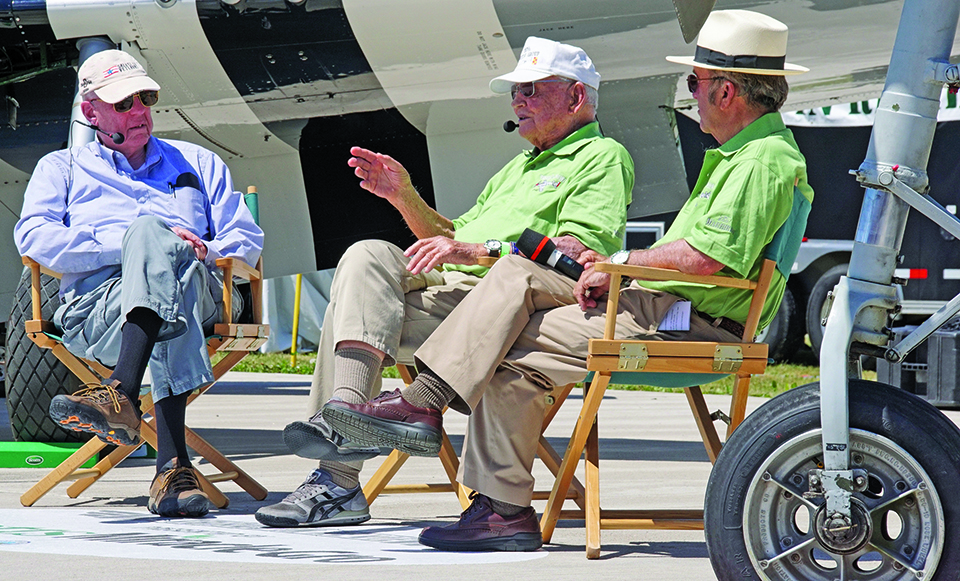Cobra to Mustang, He Flew Them
Warbirds in Review
By Frederick A. Johnsen
July 26, 2016 - World War II fighter pilot and postwar test pilot Bud Anderson held an audience of several hundred in rapt attention during a Tuesday Warbirds in Review session, backed by a rare flyable Bell P-39 Airacobra and a P-51 Mustang. Anderson flew both during World War II, training in the diminutive P-39 in the high desert around Tonopah, Nevada, and flying combat in the powerful P-51 later over Europe. It’s easy to see the fighter-pilot glint in Anderson’s eye as he recalls his exploits of more than seven decades ago.
The P-39 was a small bundle with some quirks. Its Allison V-1710 engine was mounted behind the pilot, with a two-piece drive shaft passing beneath the cockpit to a nose-mounted gearbox that swung either a Curtiss Electric or Aeroproducts propeller. This made room in the nose for a potent 37 mm cannon, two .50-caliber machine guns, and a long-legged nose wheel – uncommon in a World War II fighter. Sometimes maligned, the P-39 received some qualified love at AirVenture Tuesday. Anderson told the crowd he liked to fly the Airacobra. The first single-seat fighter with tricycle gear, he said the P-39 was “a piece of cake” on takeoffs and landings.
With its aft-mounted Allison engine, the P-39 could have aft center-of-gravity issues, he acknowledged. Stories proliferated about P-39s tumbling in flight. “I never tumbled one,” Anderson said. But after the war he asked Bell test pilots if they ever tumbled one. He said they told him it did not tumble but “it certainly did have some unusual post-stall gyrations.”
After initially checking out in a P-39 in the Bay area of California, Anderson said, “I was a so-called fighter pilot then.” But he was sent to Tonopah for more fighter training in Airacobras — training not all fighter pilots received — and Anderson credits this with improving his subsequent chances in combat. “The more experience you had, the better.”
En route to England, Anderson’s fighter group learned they would be flying new P-51B Mustangs in combat. Anderson once more received an opportunity to build flying time, now in the new Mustang, in England while attending Royal Air Force gunnery school. That added 35 pre-combat hours in the P-51 for Bud. “We didn’t even have handbooks for them,” he said.
Anderson’s combat tenure in the European Theater of Operations coincided with a change in tactics that allowed escorting U.S. fighters to pursue Luftwaffe attackers all the way to the ground in an effort to neutralize the German air force. Bud and his comrades used this new freedom of movement to leave the bomber stream and wreak havoc on the enemy fighters. He ended combat with 16 and one-quarter aerial victories. Though not the highest tally at the time, this respectable figure today makes Anderson the leading living American ace of World War II.
Anderson is quick to praise his crew chiefs in England for maintaining his Mustang in top shape. When winter snows made camouflaged Mustangs easy to spot against the white carpet, Anderson mentioned this to his crew chiefs, asking them to make his Mustang silver the next time it was laid up for maintenance. To his surprise, the next morning he walked out to his fighter to find it stripped to bare metal by the enlisted men who worked into the night. Anderson said “This was their chance to participate in the war, being excellent.” He called their actions “kind of incredible,” as the audience applauded.
The scarcity of the P-39 parked next to Anderson was not lost on the audience. Its current pilot, Bill Fier of the Commemorative Air Force, stepped up to describe the Airacobra. He said some wartime pilots in training feared vibrations of the 10-foot drive shaft. “There never was a problem” with the drive shaft, Fier said. Unnerving vibrations sometimes experienced below 800 rpm quickly cleared up as the throttle was advanced beyond that, he explained.
The audience received firsthand observations from two pilots of the Airacobra, separated by 70 years. Only at AirVenture.

